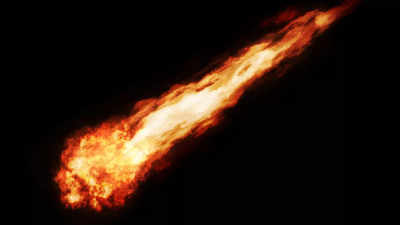Trending
140-ft yacht-sized asteroid is heading towards Earth soon: NASA
NASA has issued an alert for the upcoming close approach of a 140-foot asteroid, 2020 RL, on August 27, 2024. Traveling at 29,000 miles per hour, it will pass Earth at a distance of about 2.9 million miles. Despite the proximity, NASA assures no threat of collision. Two other asteroids, 2021 RA10 and 2012 SX49, will also make near-Earth flybys shortly after. These events highlight the importance of monitoring near-Earth objects for planetary defense.

According to NASA, a yacht-sized asteroid named 2020 RL is set to fly by Earth this coming week. Source: Canva
NASA has issued an alert regarding a significant celestial event. A 140-foot asteroid, designated 2020 RL, is set to pass by Earth on August 27, 2024. This asteroid, comparable in size to a large yacht, will make its closest approach at a distance of approximately 2,910,000 miles from our planet. While this may seem like a considerable distance, it is relatively close in astronomical terms, prompting NASA to keep a strict and vigilant watch.
Asteroids are remnants of formation of inner solar system, and their relatively unchanged state can reveal a lot about the events that led to the creation of Earth. They might also give a clue about the origins of water and other raw materials that made life possible on Earth.
Asteroid 2020 RL is traveling at an impressive speed, estimated to be around 29,000 miles per hour. Despite its rapid pace and proximity, NASA assures that there is no threat of collision with Earth. The asteroid’s trajectory has been carefully monitored, and it will safely pass by without any impact.
Following closely on the heels of 2020 RL, two other asteroids are also set to make their near-Earth approaches. On August 28, 2024, asteroid 2021 RA10 will pass by at a distance of about 1,620,000 miles. This asteroid, slightly smaller at 92 feet in diameter, will also travel at high speeds, though it poses no danger to our planet.

The third asteroid, 2012 SX49, will make its closest approach on August 29, 2024. Measuring approximately 110 feet across, it will pass Earth at a distance of 2,660,000 miles. Like the others, 2012 SX49 is being closely monitored by NASA and other space agencies to ensure it poses no threat.
These events highlight the importance of continuous monitoring of near-Earth objects. NASA’s Jet Propulsion Laboratory (JPL) plays a crucial role in tracking these celestial bodies, using advanced technology to predict their paths and assess any potential risks. The data collected from these observations not only helps in understanding the behavior of asteroids but also aids in developing strategies for
Asteroids like 2020 RL, 2021 RA10, and 2012 SX49 are part of a larger group of near-Earth objects that regularly pass by our planet. While most of these objects are harmless, their close approaches provide valuable opportunities for scientific study. By analyzing their composition, speed, and trajectory, scientists can gain insights into the early solar system and the formation of planets.
Next in line, are two more asteroids that are set to make a close approach to Earth. They are Asteroid 2016 RJ20, Asteroid 2021 JT, which will flyby Earth on August 30 and September 1. Asteroid 2016 RJ20 is an airplane-sized asteroid, which is 64 feet in size, while Asteroid 2021 JT is just 38 feet in size.
These asteroids' impending flybys provide an indication of how chaotic our solar system is. They emphasize the necessity of ongoing observation and investigation to guarantee the security of our world. Our capacity to identify and follow these things improves with technological advancement, strengthening our defenses against any possible dangers.
Near Earth Objects are asteroids and comets with orbits that bring them within 195 million kilometers of the Sun. This brings them awfully close to Earth's elliptical path. Most near Earth objects are asteroid that have a size range from about 10 feet to 25 miles across.
Most asteroids are not uniformly shaped, and often they are pitted or cratered. When they revolve around the sun, they might also rotate quite erratically, tumbling as they go. Some 150 asteroids are known to have moons as to themselves. Asteroids also occur in binaries, meaning two bodies orbit each other.
NASA’s efforts in monitoring and studying near-Earth objects are crucial for our understanding of the universe and all that it entails. The data gathered from these observations not only contributes to scientific knowledge but also helps in developing strategies to protect Earth from potential asteroid impacts. As we look forward to the upcoming flybys, the scientific community remains committed to ensuring the safety and security of our planet.
On September 26, 2022, NASA's Double Asteroid Redirection Test(DART) mission was successful in deflecting an asteroid from its usual path through kinetic impact. The first of such experiments has boosted the planetary defence mechanism of NASA to protect us from any impending danger from space rocks.
Also, NASA is a key partner in the International Space Station, a collaborative effort involving space agencies from the U.S., Russia, Europe, Japan, and Canada. The ISS has been continuously inhabited since November 2000, serving as a microgravity and space environment research laboratory.
Did you like this article? Please let us know in the comments below!
Asteroids are remnants of formation of inner solar system, and their relatively unchanged state can reveal a lot about the events that led to the creation of Earth. They might also give a clue about the origins of water and other raw materials that made life possible on Earth.
Asteroid 2020 RL is traveling at an impressive speed, estimated to be around 29,000 miles per hour. Despite its rapid pace and proximity, NASA assures that there is no threat of collision with Earth. The asteroid’s trajectory has been carefully monitored, and it will safely pass by without any impact.
Following closely on the heels of 2020 RL, two other asteroids are also set to make their near-Earth approaches. On August 28, 2024, asteroid 2021 RA10 will pass by at a distance of about 1,620,000 miles. This asteroid, slightly smaller at 92 feet in diameter, will also travel at high speeds, though it poses no danger to our planet.

Representative image
The third asteroid, 2012 SX49, will make its closest approach on August 29, 2024. Measuring approximately 110 feet across, it will pass Earth at a distance of 2,660,000 miles. Like the others, 2012 SX49 is being closely monitored by NASA and other space agencies to ensure it poses no threat.
These events highlight the importance of continuous monitoring of near-Earth objects. NASA’s Jet Propulsion Laboratory (JPL) plays a crucial role in tracking these celestial bodies, using advanced technology to predict their paths and assess any potential risks. The data collected from these observations not only helps in understanding the behavior of asteroids but also aids in developing strategies for
planetary defense.
Asteroids like 2020 RL, 2021 RA10, and 2012 SX49 are part of a larger group of near-Earth objects that regularly pass by our planet. While most of these objects are harmless, their close approaches provide valuable opportunities for scientific study. By analyzing their composition, speed, and trajectory, scientists can gain insights into the early solar system and the formation of planets.
Next in line, are two more asteroids that are set to make a close approach to Earth. They are Asteroid 2016 RJ20, Asteroid 2021 JT, which will flyby Earth on August 30 and September 1. Asteroid 2016 RJ20 is an airplane-sized asteroid, which is 64 feet in size, while Asteroid 2021 JT is just 38 feet in size.
These asteroids' impending flybys provide an indication of how chaotic our solar system is. They emphasize the necessity of ongoing observation and investigation to guarantee the security of our world. Our capacity to identify and follow these things improves with technological advancement, strengthening our defenses against any possible dangers.
Near Earth Objects are asteroids and comets with orbits that bring them within 195 million kilometers of the Sun. This brings them awfully close to Earth's elliptical path. Most near Earth objects are asteroid that have a size range from about 10 feet to 25 miles across.
Most asteroids are not uniformly shaped, and often they are pitted or cratered. When they revolve around the sun, they might also rotate quite erratically, tumbling as they go. Some 150 asteroids are known to have moons as to themselves. Asteroids also occur in binaries, meaning two bodies orbit each other.
NASA’s efforts in monitoring and studying near-Earth objects are crucial for our understanding of the universe and all that it entails. The data gathered from these observations not only contributes to scientific knowledge but also helps in developing strategies to protect Earth from potential asteroid impacts. As we look forward to the upcoming flybys, the scientific community remains committed to ensuring the safety and security of our planet.
On September 26, 2022, NASA's Double Asteroid Redirection Test(DART) mission was successful in deflecting an asteroid from its usual path through kinetic impact. The first of such experiments has boosted the planetary defence mechanism of NASA to protect us from any impending danger from space rocks.
Also, NASA is a key partner in the International Space Station, a collaborative effort involving space agencies from the U.S., Russia, Europe, Japan, and Canada. The ISS has been continuously inhabited since November 2000, serving as a microgravity and space environment research laboratory.
Did you like this article? Please let us know in the comments below!
'Our Army Will Enter Gaza...': Arab Nation's Big Pro-Palestine Announcement Amid Israel-Hamas War
End of Article
FOLLOW US ON SOCIAL MEDIA









